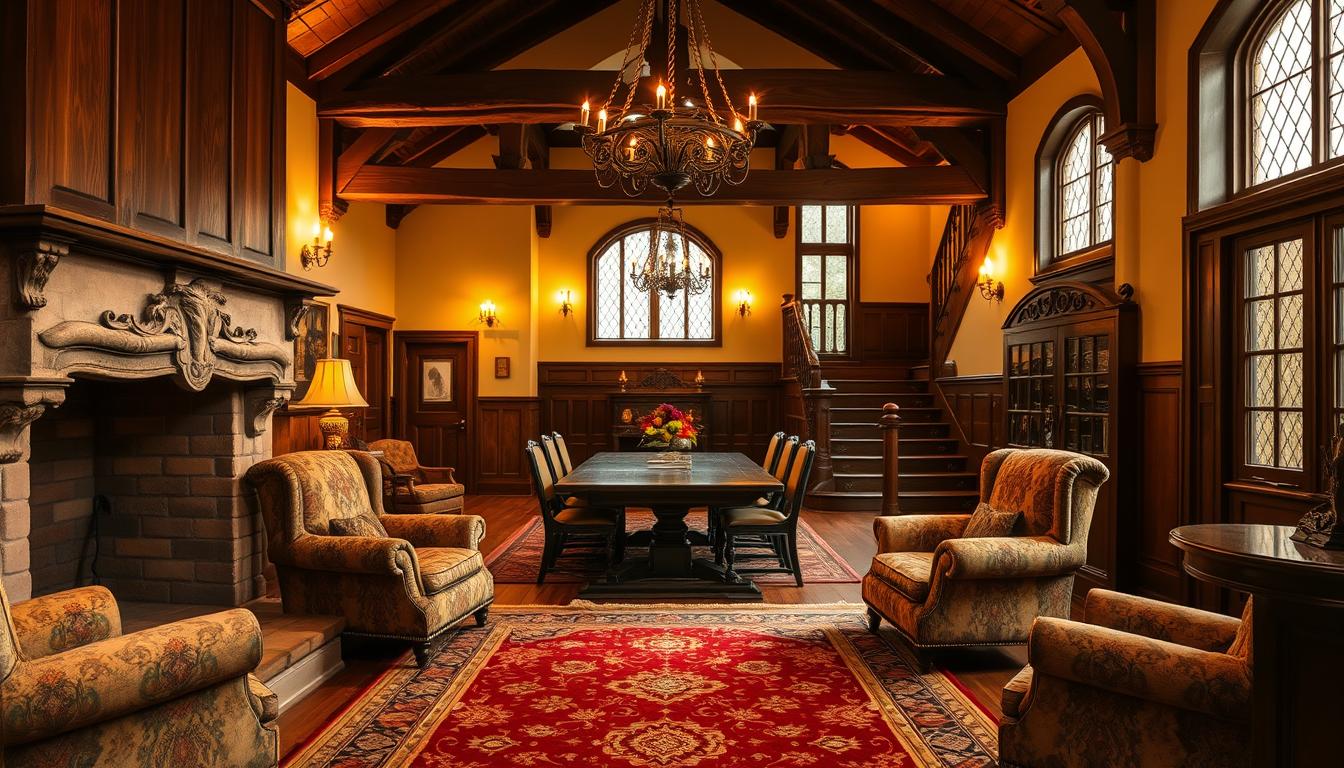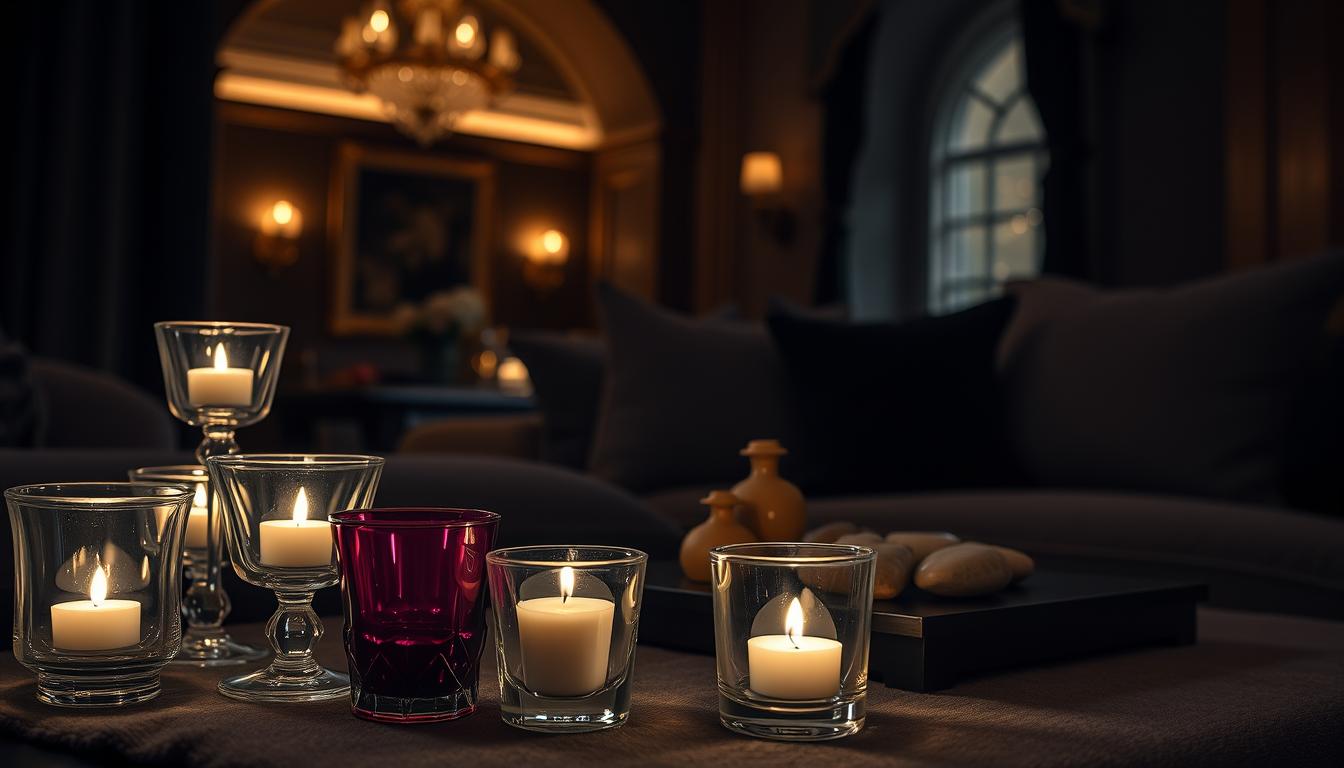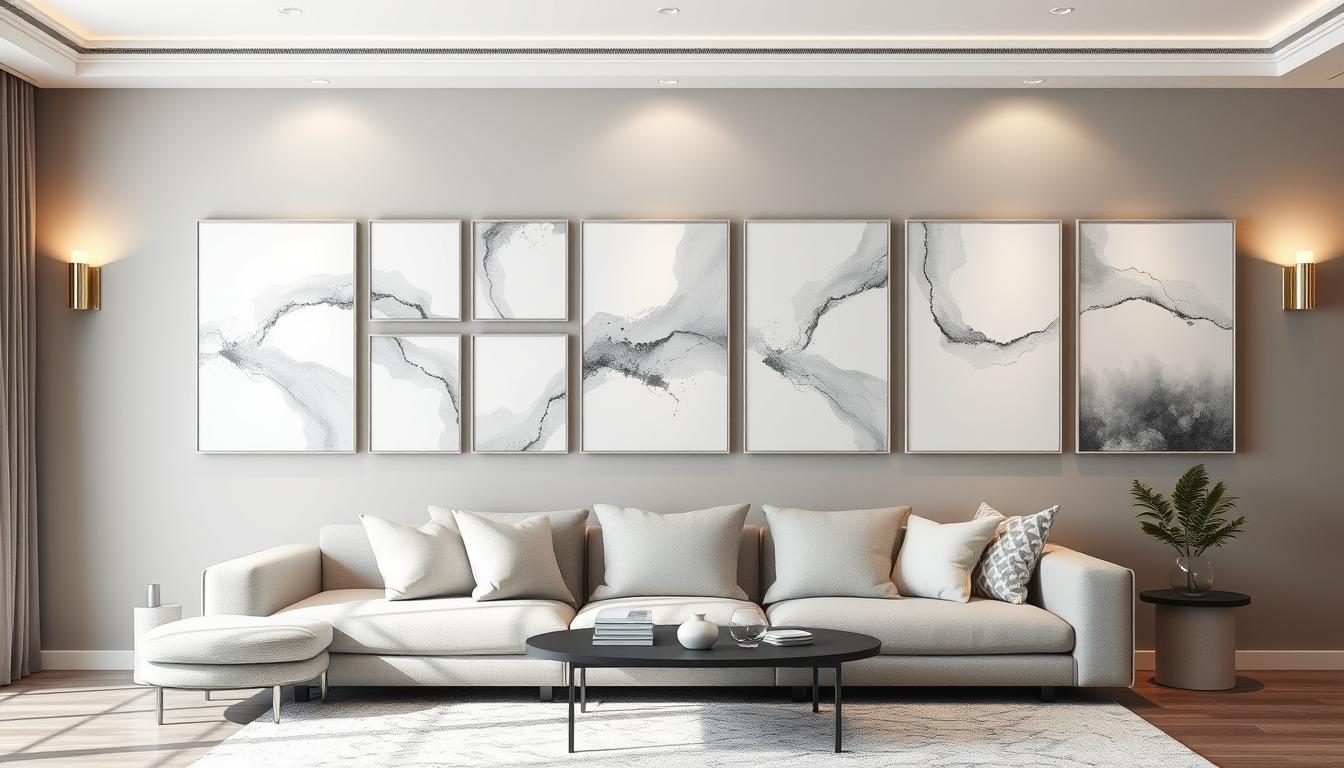Tudor-style homes have been loved for centuries. They mix medieval charm with modern elegance. The Tudor style, from 16th-century England, is now popular in the U.S. We’ll show you how to make your interior look like a Tudor home.
Want to learn more about Tudor home interior design? Check out our detailed guide on Tudor Home Interior Design. It covers architectural features, colors, furniture, and accessories. Your home will look classic and elegant.
Key Takeaways
- Understand the historical context and defining features of Tudor-style decor.
- Learn how to incorporate medieval charm into your home interior.
- Discover the essential elements for creating an authentic Tudor-inspired interior.
- Explore various design choices and decorating ideas for your Tudor-style home.
- Find out how to balance vintage allure with modern comforts.
Understanding Tudor Architecture and Its Characteristics
To design a Tudor-style home interior, knowing the history and architecture of Tudor homes is key. The Tudor period was from the 15th to the 17th century. It saw a unique architectural style that mixed medieval and Renaissance elements.
Historical Background of Tudor Homes
Tudor architecture came up during the Tudor dynasty in England. It combined Gothic and Renaissance styles. Henry VIII’s reign and the 16th century saw this style become popular. Tudor homes are loved for their tradition and heritage.
Some key historical aspects that influenced Tudor architecture include:
- The use of local materials such as brick, stone, and timber.
- The influence of medieval castles and manor houses.
- The incorporation of Renaissance decorative elements.
Key Architectural Features
Tudor homes stand out because of their architectural features. These include:
- Steeply Pitched Roofs: Often with multiple gables and complex roof lines.
- Tall Chimneys: Frequently decorated with ornate chimney pots.
- Ornate Doorways: Featuring intricate woodwork and sometimes a hood or canopy above the door.
- Leaded Glass Windows: Small, diamond-shaped panes held together by lead strips.
For more inspiration on transforming a Tudor home, check out our article on transforming a Tudor home interior design. It offers insights on keeping the architectural integrity while updating the interior.
Essential Elements of Tudor Home Interiors
Tudor home interiors are known for their warm, rich feel. This comes from using wooden beams, stone, and brick. These features add texture and interest, making the space feel real.
Exposed Wooden Beams and Ceilings
Exposed wooden beams and ceilings are key in Tudor homes. They bring warmth and a touch of history. The beams are often left natural or stained for a better look.
Benefits of Exposed Wooden Beams:
- Adds warmth and coziness
- Creates a sense of authenticity
- Provides a unique aesthetic appeal
High, vaulted ceilings also add to the grand feel. They make rooms feel bigger and more impressive.
Stone and Brick Accents
Stone and brick are vital in Tudor interiors. They’re used for walls, fireplaces, and floors. These materials bring a rustic charm and are very durable.
| Material | Common Uses | Aesthetic Contribution |
|---|---|---|
| Stone | Fireplaces, Walls | Rustic, Earthy |
| Brick | Walls, Accent Walls | Warm, Inviting |
| Wood | Beams, Ceilings | Cozy, Traditional |
Using these elements, homeowners can make a Tudor-style interior that’s welcoming and true to form. The mix of wooden beams, stone, and brick creates a timeless look.
Color Palettes for Tudor-Style Interiors
To capture the essence of Tudor style, it’s essential to select a color palette that complements its architectural characteristics. The right colors can enhance the natural beauty of the materials used in Tudor construction, such as wood and stone.
Earthy Tones and Warm Hues
Tudor homes are characterized by their use of natural materials, and the interior color palette should reflect this. Earthy tones such as ochre, sienna, and umber are ideal for creating a warm and inviting atmosphere. These colors are reminiscent of the natural world and complement the wooden beams and stone or brick accents commonly found in Tudor homes.
Accent Colors for a Tudor Vibe
While earthy tones form the basis of a Tudor-inspired color palette, accent colors can add depth and visual interest. Rich colors like deep reds, emerald greens, and navy blues can be used sparingly through furnishings, textiles, and decorative items to create a vibrant contrast with the more subdued background tones.
| Color | Hex Code | Usage |
|---|---|---|
| Warm Beige | #F5F5DC | Walls |
| Deep Red | #8B0A1A | Accent Furniture |
| Earth Brown | #964B00 | Wooden Beams |
| Navy Blue | #03055B | Textiles and Decor |
When incorporating your chosen color palette into your Tudor-style interior, consider the overall aesthetic you wish to achieve. Balance is key; ensure that your use of color enhances the natural beauty of the space without overwhelming it.
Tudor-Style Furniture Choices
Furniture is key in a Tudor-inspired home. It mixes old charm with today’s comfort. The right pieces make the space elegant and welcoming.
Classic Wood Furnishings
Classic wood furniture is a must in Tudor interior design. Oak and walnut are top choices for their beauty and strength. These woods were used back then and still are today, keeping the space true to its roots.
Look for furniture with detailed carvings or fancy designs. A carved dining table or a cabinet with fancy panels can really make your Tudor home stand out.
Upholstery Patterns and Textures
Upholstery is also crucial in Tudor home interior inspiration. Velvet, tapestry, and leather were big in Tudor times for furniture and curtains. They add warmth and make the space feel grand.
Choose fabrics that show off Tudor style, like fancy floral patterns or bold shapes. Use them in throw pillows, furniture, or wall hangings. This adds beauty and interest to your Tudor home.
By picking classic wood furniture and the right fabrics, you can make your Tudor home cozy and stylish. It will honor the Tudor tradition while being comfortable for today.
Window Styles that Define Tudor Homes
Windows are key in Tudor homes, showing off the style’s rich history. The type of window can greatly affect a Tudor home’s look and feel.
When looking at Tudor windows, we must think about both looks and function. The right windows can bring out the home’s charm and provide the needed light and air.
Leaded Glass Windows
Leaded glass windows are a hallmark of Tudor homes. These windows have small glass pieces held by lead strips, making beautiful patterns. They add elegance and connect to the style’s medieval past.
Leaded glass windows are more than pretty; they honor the style’s history. “The art of glassmaking was highly prized in medieval England,” say historians. “Leaded glass in windows showed the skill of the time.”
“The art of glassmaking was highly prized in medieval England, and the use of leaded glass in windows was a testament to the craftsmanship of the time.”
Grand Arched Windows
Grand arched windows are also typical of Tudor homes. They are bigger than leaded glass windows and have an arched top. This design adds grandeur and drama to the home’s front.
When adding grand arched windows, it’s important to balance them with other design elements. Pair them with classic wood furniture and earthy colors to complete the look.
Choosing the right windows can really make a Tudor-inspired home stand out. Whether it’s the detailed leaded glass or the grand arched windows, the right choice can make a big difference. It brings beauty and authenticity to the home.
Flooring Options for an Authentic Tudor Look
The flooring in a Tudor-style home is more than just practical. It’s a key design element that adds to the ambiance. When picking flooring, think about Tudor architecture’s traditional features. Choose options that match them well.
Hardwood and stone are top picks for Tudor homes. Each has its own benefits and can make your home look authentic Tudor.
Hardwood vs. Stone Flooring
Hardwood flooring is common in Tudor homes, bringing warmth and character. Oak and walnut are favorites for their durability and timeless look. You can install hardwood in many patterns, from simple to complex.
Stone flooring, on the other hand, adds elegance and sophistication. Flagstone, slate, and limestone are favorites for Tudor homes, often in entryways and kitchens. Stone is tough and great for busy areas.
| Flooring Type | Characteristics | Best Use |
|---|---|---|
| Hardwood | Warm, durable, versatile | Living areas, bedrooms |
| Stone | Elegant, durable, cold | Entryways, kitchens, hallways |
Area Rugs in Tudor Interiors
Area rugs can warm up Tudor-inspired interiors, adding texture over hardwood or stone. Traditional patterns like floral and geometric designs can enhance the Tudor look.
When picking area rugs, think about your Tudor home’s color and style. Earthy tones and rich colors can add to the traditional Tudor feel.
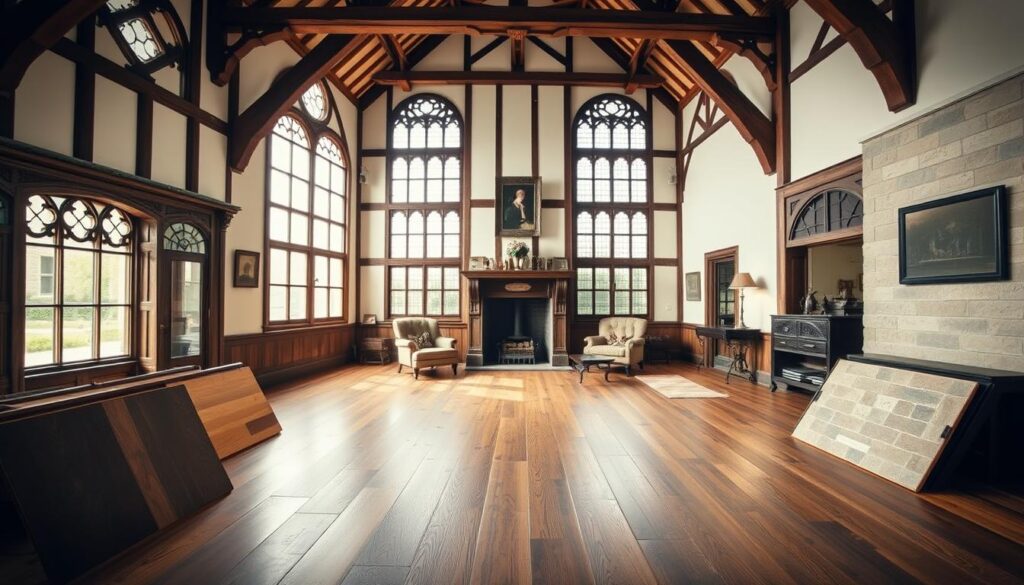
Choosing flooring that fits Tudor style can make our homes welcoming and cohesive. Whether we choose hardwood, stone, or both, and add area rugs, the right flooring can really bring out the Tudor charm in our homes.
Lighting Fixtures that Complement Tudor Design
The feel of a Tudor-inspired home is greatly affected by its lighting. It can be traditional or modern. The right lighting brings out the Tudor home’s beauty, making it warm and welcoming.
Chandeliers and Sconces
Chandeliers and sconces are key in Tudor decor. Chandeliers, often wrought iron or bronze, show off Tudor craftsmanship. Sconces add more light and match the chandelier, tying the look together.
Key Characteristics of Traditional Lighting:
- Intricate metalwork
- Candle-style or ornate lighting elements
- Materials such as wrought iron, bronze, or brass
Modern Takes on Traditional Lighting
Modern twists on classic lighting also fit Tudor style. Mixing new materials or designs keeps the look fresh. This way, homeowners can enjoy both old charm and new style.
| Traditional Element | Modern Interpretation |
|---|---|
| Wrought iron | Using wrought iron with modern glass or LED elements |
| Candle-style lighting | Incorporating energy-efficient bulbs or LED candles |
| Ornate details | Simplifying or reinterpreting ornate details with modern materials |
By mixing old and new, homes can feel both unique and cozy. This blend makes Tudor-style homes truly special.
Incorporating Modern Amenities
Adding modern comforts to Tudor homes needs careful thought. We must keep the old charm while adding new tech. This way, we make Tudor homes both classic and modern.
Balancing Technology with Tradition
Mixing old and new is all about being subtle. For example, hiding TVs and speakers in old furniture keeps the look traditional. Yet, it still lets us enjoy today’s entertainment.
Smart Storage Solutions help too. Using old trunks to hide gadgets like laptops keeps things looking right. It also keeps tech out of sight.
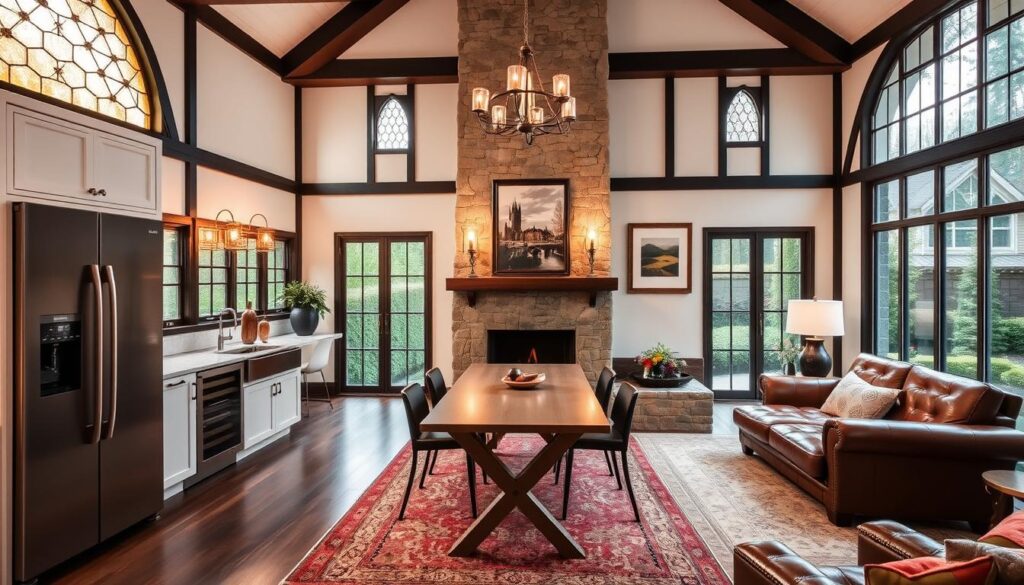
Smart Home Features in Tudor Spaces
Smart home tech can make Tudor homes better. Features like voice-controlled lighting and thermostats that learn your habits are great. They fit well with the old design.
| Smart Home Feature | Benefit | Integration Tip |
|---|---|---|
| Voice-Controlled Lighting | Convenience and Energy Efficiency | Use traditional lamp shades to house modern smart bulbs |
| Smart Thermostats | Optimized Heating and Cooling | Place the thermostat in an unobtrusive location, such as behind a decorative panel |
| Home Security Systems | Enhanced Safety and Peace of Mind | Conceal security cameras within outdoor decorative elements or inside traditional lanterns |
By adding modern tech and smart features, we get the best of both worlds. Tudor homes stay charming while offering today’s comforts.
Accessories and Decor for Tudor Style
Accessories and decor are key to capturing Tudor style in your home. The right pieces can make your space feel welcoming and complete.
Artwork and Historical Accents
Adding artwork and historical accents brings depth and character to your Tudor home. Choose pieces that reflect the era, like traditional landscapes or portraits. Historical items, such as armor displays or vintage tapestries, also add to the Tudor feel.
When picking artwork, focus on pieces that match Tudor interiors’ warm tones. Ornate frames can make your artwork stand out even more.
Textiles: Curtains and Cushions
Textiles are essential for a Tudor home’s warmth and coziness. Opt for heavy drapes in rich fabrics like velvet or tapestry. They not only keep your windows warm but also add luxury.
Choose cushions and upholstery with traditional patterns like damask or embroidery. These were popular in the Tudor era. They help tie the room together, enhancing the Tudor theme.
By carefully choosing accessories and decor that fit Tudor style, you can make your home both authentic and beautiful.
Tips for Maintaining Tudor Home Interiors
Keeping a Tudor home interior in top shape needs careful attention. We must preserve the historic features that make these homes special. This is key when we renovate a Tudor home.
Preservation of Historic Features
To keep the true look of Tudor interiors, we must protect the original details. This includes exposed wooden beams, stone fireplaces, and leaded glass windows. Regular checks can spot problems early, preventing big issues later.
Regular Care for Materials and Finishes
It’s important to regularly care for Tudor-inspired interiors. This means polishing wood, cleaning stone and brick, and fixing finishes when needed. Following these steps helps our Tudor home renovation last long.
By taking care of both preservation and regular maintenance, we can enjoy our Tudor-style homes for many years. This way, we keep the charm and character that Tudor interiors are known for.

